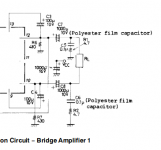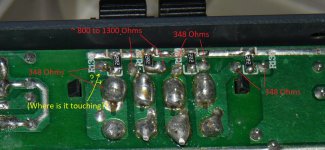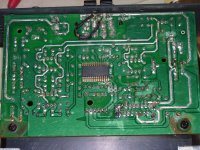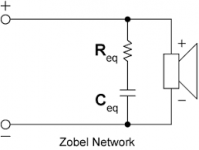NOO! Guess what!?
I tried to connect the speaker I was using to test, to where it was (a small computer speaker amplifier) and it wasn't working!
It seems that time when I was testing and flexing the board making the sound come and go, the amp blow the speaker up and a resistor, the R137, look in the photo, one of the 2R2 SMD type ones in the top, the second one from left to right, is giving me 164.7 Ohms while the rest gives me 2.5 Ohms! So I was
What I don't know is the function of those, could be the speaker terminal has some sort of protection?
The 2.2 ohm resistors are likely in series with a capacitor. This is called a zobel network, its used for output stabilisation, please see in the attached diagram C6 and R2, and C5 and R1 as examples. Please ignore the second attached thumbnail below it, i uploaded it by mistake.
The 2.2 resistor can get blown if 1. The capacitor is series with it failed and became short circuited or 2. If the amplifier IC developed severe osscilation which transiently increased the power output high enough that it blew the resistor even if it was in series with the capacitor. The amp could oscillate if the 1000uf power supply capacitor was defective. If the capacitor attached to the 2.2ohm resistor failed, it too could provoke output instability and osscilations. So I beleive that it is important to see what the capacitor in series with the 2.2 ohm resistor is working or not.
I would check the capacitor which is in series with the 2.2 resistor to make sure its functioning well.

Attachments
Last edited:
The 2.2 resistor can get blown if 1. The capacitor is series with it failed and became short circuited or 2. If the amplifier IC developed severe osscilation which transiently increased the power output high enough that it blew the resistor even if it was in series with the capacitor. The amp could oscillate if the 1000uf power supply capacitor was defective. If the capacitor attached to the 2.2ohm resistor failed, it too could provoke output instability and osscilations. So I beleive that it is important to see what the capacitor in series with the 2.2 ohm resistor is working or not.
I would check the capacitor which is in series with the 2.2 resistor to make sure its functioning well.
Thanks. Problem is that all those capacitors are between the back panel and the speaker terminal and under that one wich is not only heavily soldered but mecanically attached to the PCB (and screws but those are no problem of course), and that my multimeter doesn't measure capacitance..and that I don't know what kind of capacitors are those, ceramic, tantalum or film or what...
Is there any way to measure or test those without having to disassemble all that? I know the analog multimeter test but don't know if it will work here and while I have one of those I think is broken anyway...
Maybe I will change the 1000uF one just in case, you know for what you said, and I'll se what to do with all the rest.
By the way I repaired two cables from the chip to the speaker terminal and now everything seem to be working "fine". Except of course I stil don't know what the initial problem was. Probably what I suspected from the beggining, a cockroach added moisture and provoked a short, and now after a time without using the amp, got dry and that's why is working. But don't know if that could also be the cause for killing my soundcard...
Oh and after the repair the 2R2 resistor that gave me 164 Ohms or so, now gives me nothing, while the other 3 are giving me 2.5 Ohms consistently (equipment disconnected from power).
By the way I repaired two cables from the chip to the speaker terminal and now everything seem to be working "fine".
Oh and after the repair the 2R2 resistor that gave me 164 Ohms or so, now gives me nothing, while the other 3 are giving me 2.5 Ohms consistently (equipment disconnected from power).
If everything is working fine, then i would suggest you leave it as it is. We know that everything apart from that 2.2 resistor is working, so lets leave things as it is. Its the best result we could have hoped for without advanced equipment or a visit to the technicians
Last edited:
If everything is working fine, then i would suggest you leave it as it is. We know that everything apart from that 2.2 resistor is working, so lets leave things as it is. Its the best result we could have hoped for without advanced equipment or a visit to the technicians
Oh yes, sure is the best result! (if it's really working fine) But isn't it dangerous? Shouln't I replace the 1000uF cap or even the 2r2 with at least a normal through-hole 1/4 or 1/8 watt resistor?
IF rest of the amplifier works and only visible problem is the 2.2 ohm resistor, then replace it.
That it is destroyed means amplifier oscillated ... hard ....
And next time chip will be destroyed, so bettervreplace resistor, Zobel network is there for a reason.
That it is destroyed means amplifier oscillated ... hard ....
And next time chip will be destroyed, so bettervreplace resistor, Zobel network is there for a reason.
IF rest of the amplifier works and only visible problem is the 2.2 ohm resistor, then replace it.
That it is destroyed means amplifier oscillated ... hard ....
And next time chip will be destroyed, so bettervreplace resistor, Zobel network is there for a reason.
Yes, please replace the 2.2 ohm resistor, but could you check the capacitor which is in series with it before that. Just to make sure that the reason the 2.2ohm resistor did not blow due to a shorted capacitor. You can do it with your resistance meter, a good cap should show infinite resistance. If the cap is good, then as JMFahey says, please replace the 2.2ohm resistor with a 2.2ohm 1watt resistor.
IF rest of the amplifier works and only visible problem is the 2.2 ohm resistor, then replace it.
That it is destroyed means amplifier oscillated ... hard ....
And next time chip will be destroyed, so bettervreplace resistor, Zobel network is there for a reason.
Ok!!
Yes, please replace the 2.2 ohm resistor, but could you check the capacitor which is in series with it before that. Just to make sure that the reason the 2.2ohm resistor did not blow due to a shorted capacitor. You can do it with your resistance meter, a good cap should show infinite resistance. If the cap is good, then as JMFahey says, please replace the 2.2ohm resistor with a 2.2ohm 1watt resistor.
Will do!!
I don't think the readings are the expected ones: in 3 capacitors I get 348 Ohms, while in the one with the broken resistor gives me between 800 and 1300 Ohms. All without desoldering because as I said is hard to get to them (if I find some is broken then I wil dissasemble which will be a pain). And it doesn't seem to increase (isn't supposed to do that? bah I don't know...).


Last edited:
That´s the problem, you are measuring *in* circuit, so there are other components in parallel.
But still you measure a higher resistance where the resistor is the suspect one, so it´s either open or not there.
It IS charging ... in about 1 /1000th of a second 😱, try to catch that 😀
But still you measure a higher resistance where the resistor is the suspect one, so it´s either open or not there.
You expect it to see it charge with meter current?And it doesn't seem to increase (isn't supposed to do that? bah I don't know...).
It IS charging ... in about 1 /1000th of a second 😱, try to catch that 😀
That´s the problem, you are measuring *in* circuit, so there are other components in parallel.
But still you measure a higher resistance where the resistor is the suspect one, so it´s either open or not there.
AAaahhh so I have to change it...damn...And I don't even know the value or the type of those, I mean probably it has the value written, but the type...it's a yellow axial type...is it important the type (maybe it has polarity?) in a Zobel network?
You expect it to see it charge with meter current?
It IS charging ... in about 1 /1000th of a second 😱, try to catch that 😀
But I'm fast...haha I thought it started to increase the resistance gradually and slowly...not like that...haha. As I said, I didn't know...
Well, a little late, but last week I finally replaced the 2,2 ohms resistor and the 1000 uF cap (just in case).

Assembled it and used with my speakers, and it worked as it should. Another difference it has with mine is that when you turn it on it makes a loud pop, mine is not even half the intensity...but my brother told me it was always like that...
Well, I already gave it to him and he's enjoying it.
So, thanks to all who helped me. 🙂

Assembled it and used with my speakers, and it worked as it should. Another difference it has with mine is that when you turn it on it makes a loud pop, mine is not even half the intensity...but my brother told me it was always like that...
Well, I already gave it to him and he's enjoying it.
So, thanks to all who helped me. 🙂
- Status
- Not open for further replies.
- Home
- Amplifiers
- Chip Amps
- TDA7379 Based amplifier problem.
